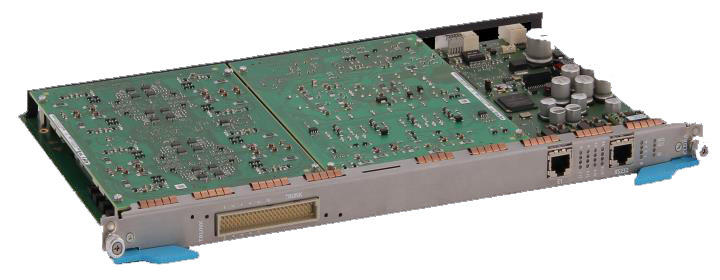Board of analogueue connecting circuits PIA
Board PIA allows the users of products TCS to protect their existing investments via provision of possibility of support of connections and creation of internetwork connectivity between existing equipment and platform TCS, compact programming switch cCS TCS.

Image 10: Board CLD with two daughterboards
The PIA board includes a motherboard and two additional boards dedicated to individual interfaces.
Main characteristics:
- Realization of functions of access and analog-digital transformation;
- Uplink connection on the base of E1/TDM with TCS cCS system;
- Option of use as a peripheral board cCS during installation into the main board or as a remote board cCS (through E1)
- Utilization of Ethernet for the purpose of administration and maintenance;
- Use of TCS MN for centralized control, diagnostics, registration, and emergency signaling;
- Compatibility with MED board together with 1U with 6, 10, or 20 slots.
Characteristics and functions:
- Flexible sets of lines, providing the option to adjust to various resistances on the line: apart from supporting resistances 300/470/600/1500 Ohm, there is an option to support set resistance according to ETSI.
- Moreover, a special version that supports incoming resistance over 30kOhm is available.
- 4-wired version, in compliance with CCITT Q.553 (interface C11);
- 2-wired version, in compliance with CCITT Q.552 (interface C22);
- Built-in frequency correction (frequency corrector) for reduction of effects of nonlinear attenuation in cable lines of extended length;
- Protection from overload in compliance with recommendations ITU-K.20 and ITU-K.44;
- Support of 2/4-wired analog connecting lines;
- Flexible support of analogueue signalling: 1VCH (1600Hz, 2100Hz, 2600Hz), 2VCH 1200/1600Hz – equipment of long distance automatic connectivity energy, 2VCH (600hz/750Hz, 1200Hz/1600Hz), impulse signalling or signalling DTMF E&M, standard types of signalling OTC (2/7, 2/11, radio, DS, PGS, MZhS);
- Signaling types LB (Non-selective mode LB; selective mode EIP and ADASEL for calling signals);
- Support of special 2-wired ports FXS providing balanced operation of two interfaces on the same line – one interface for each side of the line and long-haul lines FXS (with the resistance of loop circuit up to 3 kOhm);
- Support of relay interfaces (receipt/control over external devices);
- Support of broadband speech;
- Support of special ports FXO;
The board is controlled via TCS MNS Management System, allowing to conduct of centralized activities for installation, reserve copy, equipment data collection, quality of service and resource allocation, failure control, and control over productivity. Operators may control the ISDN subscribers through OSS/BBS systems, using the «Server Interface» (NBI) of the OpenMN system which is a part of TCS MNS.
Copyright © 2020 - All Rights Reserved - Venisat Technology Limited
